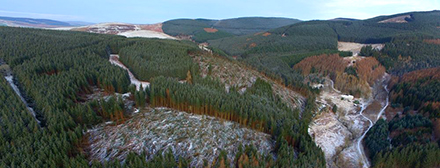Storm Arwen will help Scotland meet its climate change targets despite flattening and damaging eight million trees across the country, the Sunday National has been told. Source: The National
Rather than be a complete disaster for the forestry sector, the storm has presented an opportunity to drive forward resilience and species diversity, according to Scottish Forestry’s head of operational delivery, Doug Howieson.
Woodland cover in Scotland is currently 19% with the Scottish Government aiming to increase this to 21% by 2032.
“We are well on track to achieve that, and Storm Arwen does not deplete it in any way because we will be replanting and will structure the forests to make sure we have more diversity in terms of species and age,” he said.
“That will make the woodlands more resilient to storms and will help us in our climate change targets. We can see what we can do differently as a result of Storm Arwen.”
While the UK as a whole imports 80% of its timber requirements and is the second biggest net importer of timber in the world next to China, Scotland is a net exporter of timber.
“Scotland is well ahead of the rest of the UK in combatting that imported timber element because of the efforts we are putting in,” said Mr Howieson.
“The situation is much better here because of the investment the Scottish Government is making in woodland creation. We have a greater forest and woodland resource and are adding to that all the time.
“For all replanting now we would expect at least 25% to be made up of native broadleaf, open space and other conifers rather than the main one that was planted. The storm gives us the opportunity to drive forward resilience and species diversity.”
However, it will be almost a year before all public access to affected woodlands will be restored.
“By this time next year everything will be cleared up and back to normal and all the paths will be open,” he predicted. “It takes a bit of work to mobilise people and machinery and do the planning.
Some of the sites are protected habitats so we can’t just race into them and start felling trees. We need to make sure felling has no impact on badger setts or protected bird species, for example.” Scottish Forestry is working with the timber industry and Forestry England to make sure the clean-up is undertaken collaboratively so that villages are not exposed to undue disruption from wagons and sawmills are not overwhelmed.
A meeting has already been held in the northeast of Scotland and one will be held this week in the south of the country. What we are trying to do is get everyone together to try and co-ordinate the response in a collaborative way so we can clear it up with the minimum amount of impact on forest users and the general public Mr Howieson explained.
“For example, we have put the forestry sector in touch with local authorities to ensure the movement of timber wagons is carefully managed and the timber growers are in touch with the sawmills to create a wider sector response in a structured non-panicked way.
“We want to make sure timber wagons are properly utilised and the carbon footprint of tidying this up is as low as possible. If we have all these timber wagons moving to an area where they don’t need to, that increases the carbon footprint and causes more disruption to villages in the way.”
As the storm blew over most of the trees, rather than snapping off branches, the timber is still viable and can go to market. In Scotland about five million cubic metres of timber are felled every year and this represents, at worst, a fifth of that.
Satellite data and imagery has been used for the first time to assess the scale of the damage and there is an interactive map which can be accessed on the Scottish Forestry website which shows the worst hit areas.
“To be able to turn this information around through satellite data very quickly is a new novel approach for us and so far, has been very successful,” said Mr Howieson.








